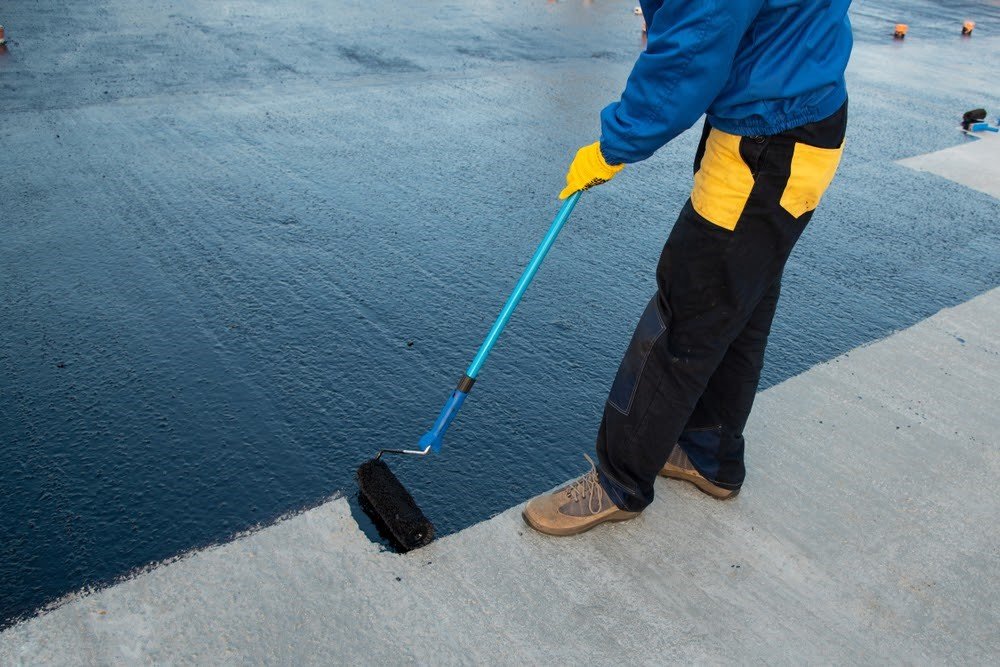Types of Waterproofing :
- Cementitious Waterproofing
- Liquid Waterproofing Membrane
- Bituminous Coating
- Bituminous Membrane
- Polyurethane Waterproofing
- Polyurea Waterproofing

Cementitious Waterproofing
Cementitious waterproof coatings are typically two-component blends used behind tile, over masonry patching, and over concrete surfaces.
These above and below-grade waterproofing coatings have good affinity to concrete and masonry substrates due to their cementitious nature, and thus strong bonding strength. The polymer modifier contributes to the flexibility properties.
Liquid Waterproofing Membrane
Liquid-applied membrane adalah lapisan monolitik, terikat penuh, berbasis cairan yang cocok untuk banyak aplikasi waterproofing dan atap.
Lapisan tersebut mengering untuk membentuk membran kedap air elastomer seperti karet dan dapat diaplikasikan pada banyak substrat, termasuk aspal, aspal dan beton.
Membran waterproofing mengandung 100% cairan poliuretan yang menjadikannya solusi pamungkas bahkan untuk aplikasi yang paling menuntut sekalipun. Ini menciptakan membran elastis yang seragam, tanpa jahitan atau sambungan, dengan elastisitas tinggi dan ketahanan mekanis, kimia, termal dan pengaruh akibat cuaca
Waterproofing membrane adalah pelapis kedap air yang diaplikasikan dengan cara dibakar
Waterproofing membrane ini merupakan pelapis kedap air yang sangat baik untuk bangunan dan mempunyai kelembaban yang cocok untuk dinding basement, dak beton, kolam renang dan balkon
Bituminous Coating
Polymer-modified asphaltic waterproof coatings are bitumen-based fluid-applied coatings often for below-grade applications.
Asphalt has very good water resistive properties, however, lacks strength at ambient temperature and flexibility at lower temperatures. Formulations using polymer-modified asphaltic emulsions see major improvements in coating performance.
Polyurethane Waterproofing
Polyurethane is made up of two components, base and reactor. Polyol acts as the base, while isocyanide is the reactor component.
The combination of both these in a specific design ratio creates a liquid coating for waterproofing applications.
Polyurethane is a rather popular choice due to its ease of installation. Unlike other waterproofing systems like sheet membranes and liquid applied membranes, this polyurethane application requires comparatively less skill and supervision.
Application is fast and this type of treatment can be used for post construction applications as well.
Advantages of Polyurethane waterproofing
- Good behavior under limited water ponding UV resistant and resistant to yellowing and weathering
- Highly elastic and crack-bridging
- Non-toxic and VOC compliant water based coating
- One component – ready to use
- Excellent adhesion on porous and non-porous substrates
- Seamless waterproofing membrane
- Water vapour permeable
Usage
- For waterproofing solutions in both new construction and refurbishment projects
- For roofs with many details and complex geometry when accessibility is limited
- For cost efficient life cycle extension of failing roofs
- For reflective coating to enhance energy efficiency by reducing cooling costs
Polyurea Waterproofing
Advantages:
*Very good crack-bridging ability
*Very fast reactivity and curing time
*High elasticity
*Seamless
*Hard wearing
*Outstanding bond strengths
*Good resistance to specific chemicals
Usage:
*Waterproof coating on concrete and cementitious screeds substrates
*Outdoor & Indoor
*Portable water tank lining
*Swimming pools & waste water tank
*Parking
*Bridge Coating
*Sewage treatment plants
SIKA – FOSROC – MAPEI – PROPAN – ESTOP – PENTENS – GRACE
